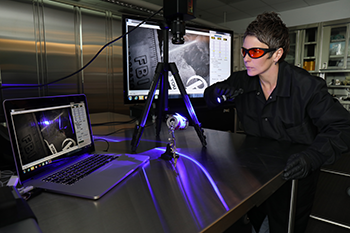Learn
Fingerprint Lab
IAFIS
For a criminal case, a computerized system is used to search various local, state, and national fingerprint databases for a potential match.
The FBI’s Integrated Automated Fingerprint Identification System (IAFIS) is the largest fingerprint database in the world. It holds over 100 million print records from criminals, military personnel, government employees, and certain civilians which may have required a fingerprint background check for employment or other purposes.

Fingerprint Examiners
The fingerprint examiner looks at the quality and quantity of information in the print to find areas of agreement or disagreement between the print collected from the crime scene (unknown print) and the prints on file (known prints).
- During the examination, the examiner may use a magnifier known as a loupe.
- A pointer, or ridge counter, is used to count the friction ridges.
ACE-V Method
The ACE-V method is used to reach a determination on each print.
ACE-V Method: A is for Analysis
The examiner will determine if a print is suitable for examination. The print must be of adequate quality and show enough features of the print to make a comparison. During analysis, the examiner may indicate key physical features to use for comparison (deltas, creases, or scars).

ACE-V Method: C is for Comparison
The analyst will compare the known and unknown print side-by-side.

ACE-V Method: E is for Evaluation
The examiner decides if the prints are from the same source or different sources. The following conclusion are possible:
- Identification or individualization - Stating that the prints came from the same source.
- Exclusion - Stating that the prints did not come from the same source.
- Inconclusive - Stating that a conclusion cannot be reached due to poor quality samples, lack of comparable areas or lack of corresponding minutiae.
ACE-V Method: V is for Verification
Another examiner analyzes, compares, and evaluates the prints to reach their own conclusion and either support or refute the original examiner.
Knowledge Check – ACE-V Method
Match the question to the portion of the fingerprint process that attempts to answer it.
Questions
- Are the prints from the same source?
- What areas of the prints agree or disagree?
- Is the print suitable for comparison?
- Does a second examiner agree or disagree with the original conclusion?
Fingerprint Process
- Analysis
- Evaluation
- Comparison
- Verification
Answers:
- Are the prints from the same source? Evaluation
- What areas of the prints agree or disagree? Comparison
- Is the print suitable for comparison? Analysis
- Does a second examiner agree or disagree with the original conclusion? Verification